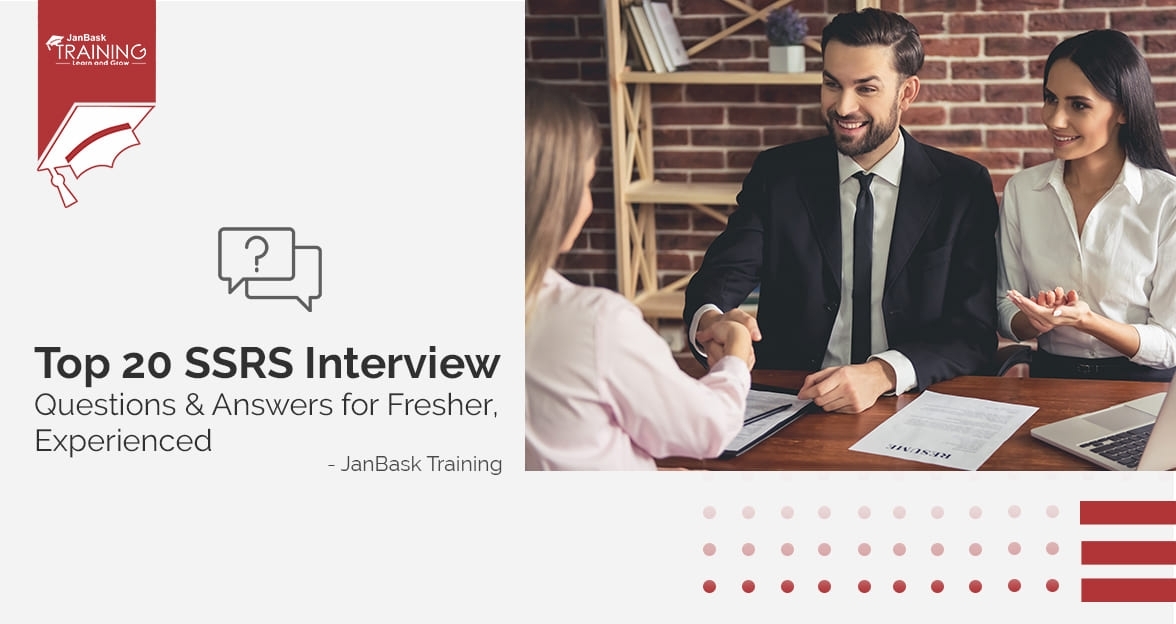 Grab Deal : Upto 30% off on live classes + 2 free self-paced courses - SCHEDULE CALL
Grab Deal : Upto 30% off on live classes + 2 free self-paced courses - SCHEDULE CALL

 Grab Deal : Upto 30% off on live classes + 2 free self-paced courses - SCHEDULE CALL
Grab Deal : Upto 30% off on live classes + 2 free self-paced courses - SCHEDULE CALL

Is your Microsoft SQL interview around the corner? Learn the most trending SQL Server Reporting Services (SSRS) interview questions and answers from basic to advanced.
To know more about SQL Server Reporting Services, enroll in our online sql server online training course.
Ans:- SSRS stands for SQL Server Reporting Services. It is a server-based reporting platform provided by Microsoft that allows users to create, manage, and deliver various reports. The primary purpose of SSRS is to enable the creation and distribution of interactive, tabular, and graphical reports.
Ans:- Report servers are essential in business intelligence (BI) because they enable users to generate reports that can be used to analyze data and make informed decisions. It empowers organizations to transform data into actionable insights, providing decision-makers with the information they need to make informed choices and drive business growth.
Ans:- RDL is an XML representation of a SQL Server Reporting Services report definition (RDL) that includes detailed data extraction and report layout facts. RDL files typically have the extension ".rdl" and can be created and edited using dedicated reporting tools such as SQL Server Data Tools (SSDT), Report Builder, or other reporting software that supports RDL.
Ans:- The critical components of SSRS include:
Ans:- Once we run the report, the detailed data is acquired, combined with the layout, and then displayed on the screen, allowing for export, printing, or saving. Users can often export the detailed data in the report to various formats like PDF, Excel, or Word for further analysis or sharing with others
Ans:- SQL Server Database Administrators (DBAs) manage the connection information, specifying server connections and required data. They play a critical role in ensuring the availability, security, and integrity of data.
Ans:- A SqlConnection object in SSRS is a class that represents a connection to a SQL Server database. It is used to connect to and retrieve data from a SQL Server database to generate reports. SqlConnection objects are used in SSRS to connect to and retrieve data from SQL Server databases to generate reports. They are an essential part of the SSRS reporting platform.
Ans:- When connecting to a Microsoft SQL Server database, using SqlConnection, SqlDataAdapter, and SqlCommand can enhance speed and efficiency. These classes are part of ADO.NET and play crucial roles in database connectivity and data retrieval.
Ans:- A shared dataset is a dataset that can be used by multiple reports, while an embedded dataset is specific to a single report. Shared datasets are stored separately and can be accessed by various reports, promoting reusability and consistency in your reports. Shared datasets can have their own security settings, which can be managed independently while the security settings for an embedded dataset are tied to the report itself
Ans:- The Report Builder is a simplified tool for creating and designing reports. It is often used by business users who may not have advanced technical skills but need to generate ad-hoc reports. Report Builder provides a user-friendly interface for report authoring. Its primary purpose is to enable non-technical users, such as business analysts and report authors, to design and publish reports without requiring deep technical expertise
Ans:- Parameters and filters are used to limit the data displayed in a report. However, parameters are user-defined values that affect the entire report, while filters are conditions applied to individual data regions or data sets within a report.
Ans:- To deploy a report in SSRS, you typically use SQL Server Data Tools or Report Builder to design the report, then publish it to the Report Server using the built-in deployment functionality. Reports are usually deployed to a specific folder on the Report Server.
Ans:- It is recommended to select the "Embedded connection" to have the connection details embedded within the report, making it self-contained.
Ans:- This connection string assumes that you have permission to access the database online and that the database, SQL Server Data Tools (SSDT), and report server are all installed on your local computer.
Ans:- SSRS offers various security mechanisms, including role-based security, item-level security, and data-driven security. You can control access to reports, data sources, and folders based on user roles and permissions. Additionally, you can use SSL encryption for secure communication.
If you're a beginner in SSRS, and want to know more about it, check our SSRS Tutorial for beginners blog.
Ans: All properties of a SqlConnection object are initially set to their default values, which are listed in the SqlConnection function as "[native code]." Here are the initial property values for a SqlConnection object:
Mastering SSRS and preparing for an SSRS interview involves a deep understanding of its components, report design principles, and security measures. By reviewing these interview questions and answers, you've taken a significant step toward showcasing your SSRS proficiency and ensuring a successful interview. Whether you're an experienced SSRS user or just starting your SSRS journey, continuous learning and preparation are the keys to mastering this invaluable reporting tool. Good luck with your SSRS interviews!

SQL Server MERGE Statement: Question and Answer


Mastering INSERT and OVER DML Syntax: Interview Questions Guide

Top SSRS Interview Questions And Answers

Cyber Security

QA

Salesforce

Business Analyst

MS SQL Server

Data Science

DevOps

Hadoop

Python

Artificial Intelligence

Machine Learning

Tableau
Download Syllabus
Get Complete Course Syllabus
Enroll For Demo Class
It will take less than a minute
Tutorials
Interviews
You must be logged in to post a comment